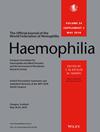Hand and Foot Subungual Haematomas in Haemophilia: A Report of Six Cases
Abstract
Aim
Subungual haematomas are a collection of blood underneath the nail subsequent to trauma. Whilst a commonly recognised injury in the general population, there is limited literature and no guidelines for management in haemophilia patients. This case series aims to provide insight into the clinical characteristics, management and sequelae of subungual haematomas in the haemophilia group.
Methods
A retrospective case series was performed of patients with haemophilia presenting with subungual haematomas between July 2018 and June 2024, and the background literature reviewed. Data were collected from electronic medical records and analysis was purely descriptive given the small cohort included.
Results
Six individual cases were identified with traumatic subungual haematomas. Five patients were male (83.3%), there was an event split between haemophilia A and B cases, with severity ranging from mild to moderate. One patient with mild haemophilia A also had concurrent type 1 von Willebrand disease. Most cases (83.3%) had a 48–72 h delay before hospital presentation. Five cases (83.3%) required either nail trephination or removal. Two moderate haemophilia B patients (33.3%), had recurrent bleeding within the first 2 weeks post injury.
Conclusion
Haemophilia patients presenting with subungual haematomas should be considered for nail trephination or surgical intervention as per standard of care following factor replacement. Larger patient series may provide more insight into comparative outcomes in haemophilia patients versus the general population. Early collaboration between haematology and surgical teams is important. Inclusion of this site-specific bleed into patient education resources and haemophilia guidelines warrants consideration.

 求助内容:
求助内容: 应助结果提醒方式:
应助结果提醒方式:


